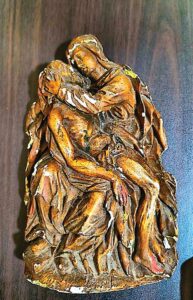Collector Learns the Truth About Antique-Looking Artwork


Q: I wondered if you might have any information about this seemingly antique statue I’ve acquired. It depicts Christ and the Virgin Mary. The back is inscribed with the number “1796.” Thank you for your time and assistance.
A: Your statue is a stylized version of Michelangelo Buonarroti’s Pietà di San Pietro (1498–1499), which depicts the Virgin Mary cradling Jesus after his removal from the cross, representing her sixth sorrow. While Michelangelo created three distinct Pietàs—the Pietà di San Pietro, Pietà Bandini, and Pietà Rondanini—the Pietà di San Pietro remains the most iconic. The term pietà translates to pity in Italian. Your statue lacks information on dimensions or material composition but appears to be brown-stained plaster. Plaster was widely used in the 18th century for reproductions of classical sculptures, but your piece seems to be a poorly stained 20th-century copy, inscribed with a questionable date of “1796.” Based on its quality and apparent age, its value is estimated at $20–$25.
Our guest appraiser is Dr. Anthony Cavo, a certified appraiser of art and antiques and a contributing editor to Kovels Antique Trader. Cavo is also the author of Love Immortal: Antique Photographs and Stories of Dogs and Their People.
You May Also Like:
Villeroy & Boch: Looks Like a Fortune, Priced Like a Find